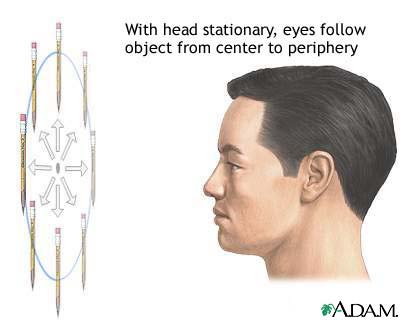Extraocular muscle function testing
EOM; Extraocular movement; Ocular motility examination
Extraocular muscle function testing examines the function of the eye muscles. A health care provider observes the movement of the eyes in eight specific directions in addition to straight ahead.

The eye is the organ of sight, a nearly spherical hollow globe filled with fluids (humors). The outer layer or tunic (sclera, or white, and cornea) is fibrous and protective. The middle layer (choroid, ciliary body and the iris) is vascular. The innermost layer (the retina) is nervous or sensory. The fluids in the eye are divided by the lens into the vitreous humor (behind the lens) and the aqueous humor (in front of the lens). The lens itself is flexible and suspended by ligaments which allow it to change shape to focus light on the retina, which is composed of sensory neurons.

The extraocular muscle function test is performed to evaluate any weakness, or other defect in the extraocular muscles which results in uncontrolled eye movements. The test involves moving the eyes in eight different directions in space to evaluate the proper functioning of the extraocular muscles of the eyes.
How the Test is Performed
You are asked to sit or stand with your head up and looking straight ahead. Your provider will hold a pen or other object about 16 inches or 40 centimeters (cm) in front of your face. The provider will then move the object in several directions and ask you to follow it with your eyes, without moving your head.
A test called a cover/uncover test may also be done. You will look at a distant object and the person doing the test will cover one eye, then after a few seconds, uncover it. You will be asked to keep looking at the distant object. How the eye moves after it is uncovered may show problems. Then the test is performed with the other eye.
A similar test called an alternate cover test may also be done. You will look at the same distant object and the person doing the test will cover one eye, and after a couple of seconds, shift the cover to the other eye. Then after a couple more seconds, shift it back to the first eye, and so on for 3 to 4 cycles. You will keep looking at the same object no matter which eye is covered.
How to Prepare for the Test
No special preparation is necessary for this test.
How the Test will Feel
The test involves only normal movement of the eyes.
Why the Test is Performed
This test is performed to evaluate weakness or other problems in the extraocular muscles. These problems may result in double vision or rapid, uncontrolled eye movements.
Normal Results
Normal movement of the eyes in all directions.
What Abnormal Results Mean
Eye movement disorders may be due to abnormalities of the muscles themselves. They may also be due to problems with the nerves that connect to these muscles or in the sections of the brain that control these muscles. Your provider will talk to you about any abnormalities that may be found.
Risks
There are no risks associated with this test.
Considerations
You may have a small amount of uncontrolled eye movement (nystagmus) when looking to an extreme left or right position. This is normal.
References
Cioffi GA, Liebmann JM. Diseases of the visual system. In: Goldman L, Cooney KA, eds. Goldman-Cecil Medicine. 27th ed. Philadelphia, PA: Elsevier; 2020:chap 391.
Demer JL. Anatomy and physiology of the extraocular muscles and surrounding tissues. In: Yanoff M, Duker JS, eds. Ophthalmology. 6th ed. Philadelphia, PA: Elsevier; 2023:chap 11.1.
Forrester JV, Dick AD, McMenamin PG, Roberts F, Pearlman E, Physiology of vision and the visual system. In: Forrester JV, Dick AD, McMenamin PG, Roberts F, Pearlman E, eds. The Eye. 5th ed. Philadelphia, PA: Elsevier Limited; 2021:chap 5.
Hutchinson AK, Morse CL, Hercinovic A; American Academy of Ophthalmology Preferred Practice Pattern Pediatric Ophthalmology/Strabismus Panel, et al. Pediatric eye evaluations preferred practice pattern. Ophthalmology. 2023;130(3):P222-P270. PMID: 36543602
Version Info
Last reviewed on: 1/20/2025
Reviewed by: Franklin W. Lusby, MD, Ophthalmologist, Lusby Vision Institute, La Jolla, CA. Also reviewed by David C. Dugdale, MD, Medical Director, Brenda Conaway, Editorial Director, and the A.D.A.M. Editorial team.
